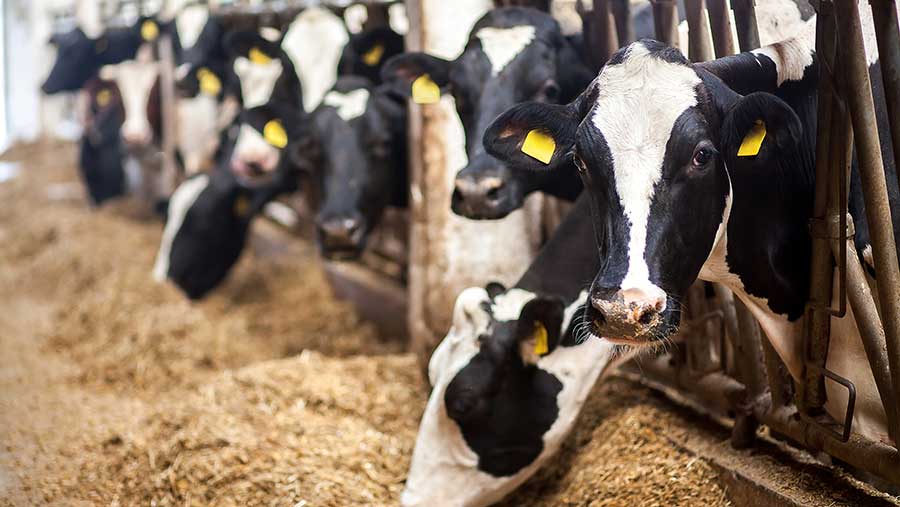Advertiser content
Maximizing your herd’s efficiency with the power of artificial intelligence
Almost all cows suffer from a period of negative energy balance during the transition period between the dry and lactating stages of the dairy production cycle.
This puts the cow at higher risk of metabolic diseases like ketosis, as well as lameness and mastitis, which affect both animal health and production.
The Dairy Data Warehouse team recently presented a Farmers Weekly webinar to discuss transition cow management and presented one of its flagship solutions, Predicta GUARDIAN.
The tool uses artificial intelligence (AI) to run daily checks on herd management software, registering unusual events and flagging any at-risk animals.
Dr Armin Pearn, head of insights, said: “The tool is designed for farmers who want to run targeted prevention programmes for transition cows.”
What is negative energy balance and why is it a problem in some animals?
Cows experience a huge change after calving, from being dry to producing large quantities of milk.
This creates a sizeable energy demand, which the animal often cannot meet due to reduced dry matter intakes following calving. In consequence, she will mobilise fat to meet her energy needs.
Many animals go undetected as suffering from metabolic diseases on a subclinical basis. Undetected animals will produce less milk, be susceptible to further disease and experience fertility difficulties.
What are the potential signs a herd is suffering from transition diseases?
While it is normal to mobilise fat and lose weight during the first 40-60 days of lactation, some animals develop metabolic diseases which produce visible knock-on effects.
These can be seen in herds that struggle with fertility, resulting in longer lactations and higher body condition scores at calving.
Newly calved cows are 30% more likely to get ketosis. It therefore makes sense to have a targeted risk management programme like Predicta GUARDIAN on farm.
Farmers using this tool have realised that subclinical ketosis had gone undiagnosed on their farms.

© Predicta GUARDIAN
Is prevention better than cure?
From an animal welfare perspective, it is always better to prevent than cure. From an economic perspective it is dependent on the frequency and level of disease.
Any herd with a ketosis incidence of 30% or more will benefit economically from a prevention scheme.
For herds with just 5-10% incidence it is more economic to focus on treatment. Mid-risk herds need to identify their high-risk cows to avoid a blanket scheme. Predicta GUARDIAN can be used for this purpose.
How does Predicta GUARDIAN work and how accurate is it?
Predicta GUARDIAN is a risk management tool. The model utilises AI to analyse cow production parameters to predict the animal’s risk of getting four known transition diseases: Ketosis, milk fever, retained placenta and displaced abomasum.
It uses milking and reproduction data gathered from the previous lactation to make predictions of when a cow may be about to develop transition cow disease.
It will then send an alert six to eight weeks before the cow is at risk, giving the farmer a long window in which to instigate preventative measures during the drying off period.
The product sends out these alarms, via text, email or WhatsApp, dependent on the number of incidences and level of sensitivity.
It can be adjusted to focus on the diseases the farmer is interested in and set to alert at different frequencies, such as daily or weekly.
Farmers should have a clear prevention protocol put in place, ideally in conjunction with a veterinary professional, for when alerts of each disease are received.
The application runs from a website which allows farmers look at in-depth herd information, although daily they can access the most essential data on their mobile.
Users can view the estimated disease incidence of the herd each month and observe overall herd risk factors like the calving interval. They can also see aggregated data for animals identified as at risk for closer examination of cases.
The algorithm is 60-70% accurate, which is sufficient to deliver a positive economic outcome for the producer.
What are the technical requirements for Predicta GUARDIAN?
Farmers just need a computer with popular herd management software and internet access. The programme is operated via subscription with farmers still owning their data. To get started, users need to input historic milk production data and reproduction information.
Why should farms try Predicta GUARDIAN?
The farmers who will benefit most are the ones who would like to improve their fertility and identify the root causes of transition cow diseases. When used in conjunction with a prevention scheme, high and low incidence herds can achieve a saving of £8-10/cow per year, compared with not taking any action.
What is the cost of the product?
Dairy Data Warehouse currently has a free trial for the first two months of Predicta GUARDIAN after which users start paying monthly: The cost based on a 300 cow herd in the UK would be £2.20/cow a year which works out at 18p per month.
Provided by
At Dairy Data Warehouse (DDW), we unlock the full potential of data on dairy farms across the globe to enable the industry to harness big data and AI for sustainable and more profitable farming. DDW collects farm data from the herd management software and other sources on farm. We ensure high data quality by cleaning and transforming it into a unified, comparable set for AI driven strategic decision-making, benchmarking and insights. Our solutions support key stakeholders in nutrition, genetics, animal health, cow monitoring, and milking equipment. Let’s connect to explore how data can drive your business forward.
